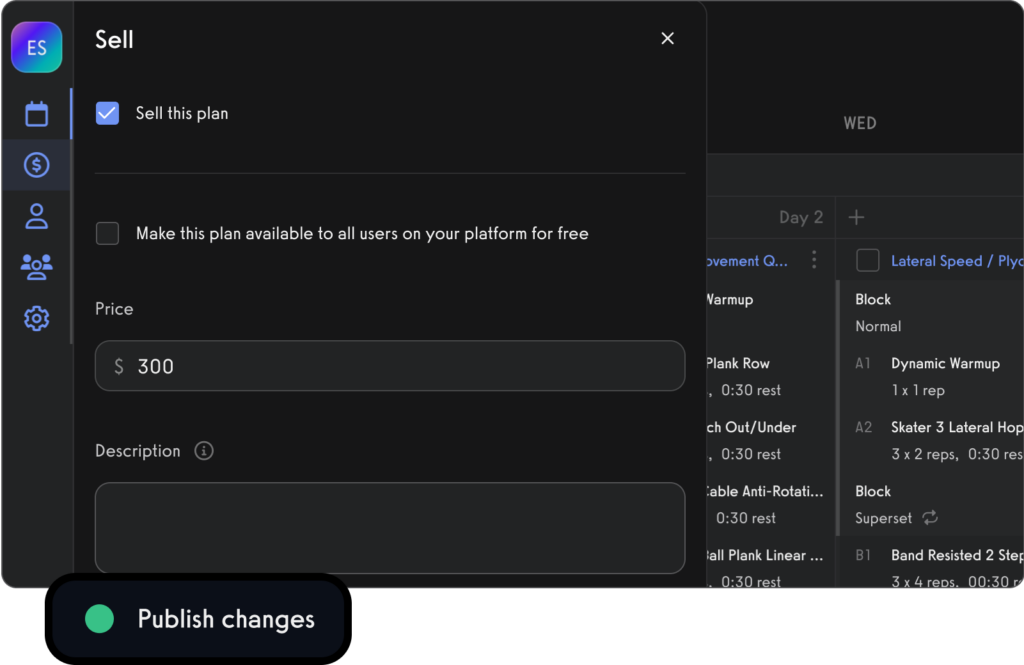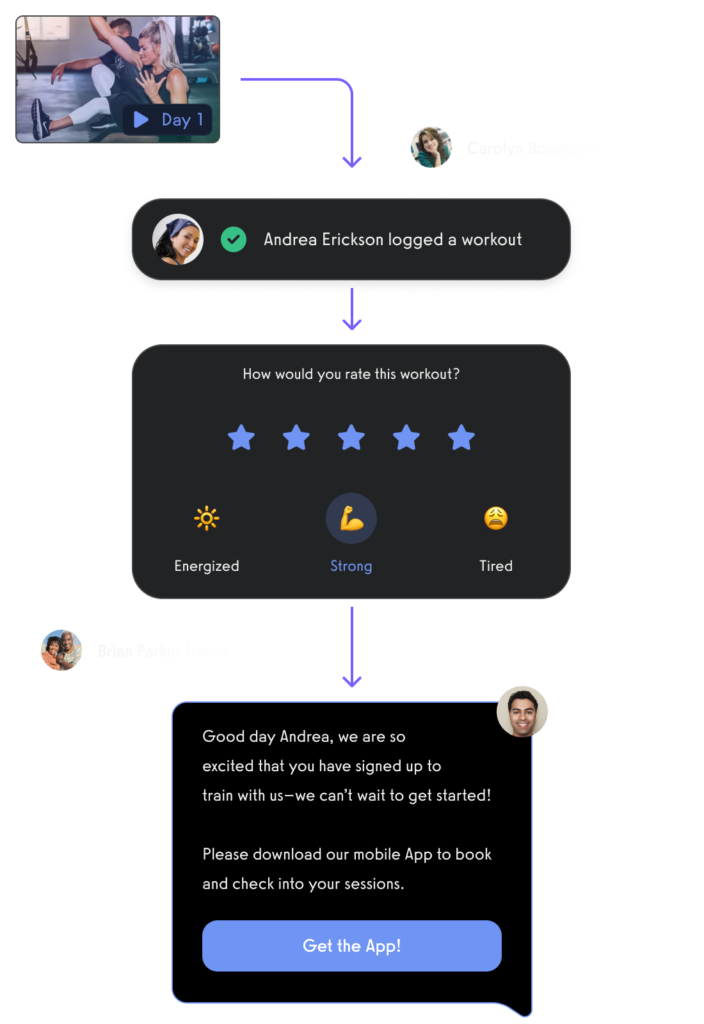CrossFit Gym Business Plan Template (PDF, DOC, XLS – FREE)
Get this free CrossFit gym business plan template in PDF, DOC, XLS to learn how to create a gym business plan. Use the free CrossFit gym business plan examples and then modify as needed.

Are you passionate about fitness and interested in learning how to start a CrossFit gym? Congratulations! Owning a CrossFit gym can be a rewarding venture, allowing you to help others achieve their fitness goals while building a successful business. However, just like any other business, it’s crucial to have a well-thought-out CrossFit business plan to ensure your gym’s success. Download our CrossFit gym business plan PDF to create a successful business plan for a CrossFit gym with a proven CrossFit business strategy for growth and profitability.
In this article, we will delve into the key components of a comprehensive CrossFit gym business plan, walk through the CrossFit business model, guiding you through each step of the process to help you achieve your entrepreneurial dreams (and if you are just interested in starting a gym that is a “regular gym”, and not a CrossFit gym, then check out this gym business plan template).
Study up to learn all about the pros and cons of owning a CrossFit gym, what being a CrossFit affiliate really means, learn how to start a CrossFit gym, how to market a CrossFit gym, how to choose the best CrossFit gym payment processor, what equipment is needed for a CrossFit gym, and then choose the best CrossFit gym management software and the best apps for CrossFit box owners to help you maximize gym revenue and profitability.

So if you are looking to start a gym then our comprehensive CrossFit gym business plan template will guide you through every step of the process, from market research to gym sales forecast financial projections. If you are looking to start your own CrossFit gym then this comprehensive CrossFit box business plan template is what you need. Be sure to also check out the fitness business plan template and the personal training business plan template.

Then be sure to find the tools you need to grow a gym business. From the best software for gym management to the best software for personal training to the best fitness software for fitness influencers, the Exercise.com platform has the tools you need to grow and manage your fitness business.

Offer booking and scheduling for your gym’s packages, sessions, memberships, and more.

Create and sell fitness memberships, products, and digital offers.

Manage, message, and market to your leads and customers.

All from your very own custom branded fitness apps.


CrossFit Gym Business Plan Template
Summary
This business plan template is designed specifically for entrepreneurs looking to start or expand a CrossFit gym. A CrossFit gym business plan should detail the gym’s strategy, operational plans, and financial projections, focusing on the unique aspects of the CrossFit training philosophy and community.
Executive Summary
- Business Name and Location: The name of your CrossFit gym and its physical location.
- Mission Statement: A concise statement that captures the essence of your CrossFit gym’s goals and approach.
- Business Goals: Define short-term and long-term objectives specific to your CrossFit gym.
- Ownership Structure: Information about the gym’s ownership, key partners, and management team.
Business Structure
- Type of Business Entity: Whether it’s a sole proprietorship, partnership, LLC, etc.
- Facility Details: Size and layout of the gym, including any unique features pertinent to CrossFit training (like rigs, ropes, and open spaces).
- Equipment and Resources: List of essential CrossFit equipment (barbells, bumper plates, kettlebells, etc.).
Market Analysis
- Industry Overview: Insights into the current CrossFit industry, trends, and growth potential.
- Target Market: Demographic and psychographic profile of your target clientele (e.g., age, fitness level, interests).
- Competitor Analysis: Overview of local CrossFit gyms and other fitness facilities, highlighting your gym’s competitive advantage.
- SWOT Analysis: Strengths, weaknesses, opportunities, and threats.
Services Offered
- CrossFit Classes: Details about the types of classes, scheduling, and programming.
- Additional Services: Other services like beginner courses, personal training, nutrition coaching, or specialized classes (e.g., CrossFit Kids, mobility classes).
- Community Events: Plans for hosting or participating in CrossFit competitions, social events, and community-building activities.
Marketing and Sales Strategy
- Branding and Positioning: How your CrossFit gym will be branded and positioned in the market (emphasizing community, competition, fitness philosophy).
- Marketing Channels: Strategies for marketing your gym (social media, community events, partnerships, local advertising).
- Sales Plan: Approach to selling memberships and services.
- Customer Retention Strategies: Methods to retain members, such as member engagement programs and feedback mechanisms.
Financial Plan
- Startup Costs: Initial investment needed for gym space, equipment, and other startup expenses.
- Pricing Strategy: Membership pricing, drop-in fees, and pricing for additional services.
- Revenue Projections: Expected income from various revenue streams.
- Expense Forecast: Regular operational expenses including rent, equipment maintenance, staffing, and marketing.
- Break-Even Analysis: Calculation of when the gym will start turning a profit.
Operations Plan
- Staffing Requirements: Number and type of employees needed (coaches, administrative staff).
- Operational Workflow: Daily operations of the gym, class scheduling, and member management.
- Facility Maintenance: Plan for maintaining and updating the gym facility and equipment.
Legal and Risk Management
- Legal Considerations: Necessary permits, licenses, and compliance with CrossFit Inc. affiliate requirements.
- Insurance Requirements: Types of insurance needed (liability, property, worker’s compensation).
- Risk Management Strategies: Safety protocols, emergency procedures, and waiver policies.
Growth and Expansion
- Future Opportunities: Potential avenues for growth such as expanding services, additional locations, or hosting larger CrossFit events.
- Long-Term Goals: Vision for the future of the gym, including community impact and business milestones.
This CrossFit box business plan template serves as a foundational structure for a CrossFit gym business plan. Each section should be tailored to reflect your specific vision, market, and operational strategy.

Example CrossFit Gym Business Plan #1: Urban CrossFit Box
Summary
“Urban CrossFit Challenge” is a CrossFit gym located in the heart of a bustling city, aiming to provide a high-intensity fitness solution to urban professionals and fitness enthusiasts. The focus is on creating a vibrant community around challenging workouts and holistic health.
Business Structure
- Type: LLC
- Facility Details: Compact urban space outfitted with essential CrossFit equipment.
- Equipment and Resources: Functional fitness gear including rigs, barbells, rowers, and space for Olympic lifting.
Market Analysis
- Industry Overview: Growing popularity of CrossFit among urban professionals.
- Target Market: Busy professionals, ages 25-40, seeking effective, community-based workouts.
- Competitor Analysis: Local gyms and boutique fitness studios; differentiation through community and unique class offerings.
- SWOT Analysis: Strength in location and community; weakness in limited space.
Services Offered
- CrossFit Classes: Regularly scheduled CrossFit classes with scalable options for all levels.
- Additional Services: Wellness workshops, nutrition counseling, and occasional outdoor fitness events.
- Community Events: Monthly member socials, local CrossFit competitions.
Marketing and Sales Strategy
- Branding and Positioning: Positioned as an inclusive, high-energy urban fitness community.
- Marketing Channels: Social media, local business partnerships, community events.
- Sales Plan: Introductory offers, corporate wellness packages.
- Customer Retention Strategies: Member recognition programs, community building activities.
Financial Plan
- Startup Costs: Moderate, primarily for location lease and equipment.
- Pricing Strategy: Competitive membership pricing with discounts for longer commitments.
- Revenue Projections: Steady growth through memberships and additional services.
- Expense Forecast: Rent, equipment maintenance, staff salaries, marketing.
- Break-Even Analysis: Within the first 18 months.
Operations Plan
- Staffing Requirements: Certified CrossFit coaches, administrative staff.
- Operational Workflow: Class scheduling, member management, event planning.
- Facility Maintenance: Regular equipment and facility upkeep.
Legal and Risk Management
- Legal Considerations: Compliance with local business regulations, CrossFit affiliation requirements.
- Insurance Requirements: Liability, property, and employee insurance.
- Risk Management Strategies: Regular safety briefings, maintaining high coaching standards.
Growth and Expansion
- Future Opportunities: Expanding class offerings, additional locations.
- Long-Term Goals: Becoming a cornerstone of urban fitness in the city.
Example CrossFit Gym Business Plan #2: Suburban Family-Focused Box
Summary
“Suburban Strength & Community” targets families and individuals in suburban areas, offering a family-friendly environment with a focus on fitness and community events. Our approach combines CrossFit training with family-oriented activities.
Business Structure
- Type: Partnership
- Facility Details: Spacious gym with an area for kids, outdoor workout space.
- Equipment and Resources: Standard CrossFit equipment plus additional gear for kids’ fitness classes.
Market Analysis
- Industry Overview: Expanding interest in family fitness solutions.
- Target Market: Suburban families, parents, and children interested in fitness.
- Competitor Analysis: Local gyms; differentiation through family-oriented services.
- SWOT Analysis: Strength in family focus; potential limitations in market reach.
Services Offered
- CrossFit Classes: Adult CrossFit classes along with family and teen classes.
- Additional Services: Childcare during classes, family health and nutrition workshops.
- Community Events: Family fitness days, local community fitness challenges.
Marketing and Sales Strategy
- Branding and Positioning: A family-friendly fitness community.
- Marketing Channels: Community bulletin boards, school partnerships, social media.
- Sales Plan: Family membership packages, referral incentives.
- Customer Retention Strategies: Engaging family programs, loyalty rewards.
Financial Plan
- Startup Costs: Moderate to high, for spacious facility and extra amenities.
- Pricing Strategy: Family package deals, competitive individual rates.
- Revenue Projections: Gradual increase as community awareness grows.
- Expense Forecast: Facility costs, staff, family-specific program expenses.
- Break-Even Analysis: Aimed within two years.
Operations Plan
- Staffing Requirements: CrossFit certified coaches, childcare staff, family program coordinators.
- Operational Workflow: Class scheduling, family event planning, community outreach.
- Facility Maintenance: Regular maintenance, with a focus on safety and cleanliness.
Legal and Risk Management
- Legal Considerations: Childcare licensing, CrossFit affiliate compliance.
- Insurance Requirements: Comprehensive liability, including child-specific coverage.
- Risk Management Strategies: Child safety protocols, family-friendly environment standards.
Growth and Expansion
- Future Opportunities: Expanding to more suburban locations, adding more family programs.
- Long-Term Goals: Being recognized as a leading family fitness center in the region.
Example CrossFit Gym Business Plan #3: Elite Performance and Training Center
Summary
“Peak Performance CrossFit” is designed as an elite training facility focusing on high-performance athletes and serious fitness enthusiasts. This gym offers advanced CrossFit training, sports performance programs, and specialized athletic services.
Business Structure
- Type: Corporation
- Facility Details: High-end facility with advanced equipment, specialized areas for athletic training.
- Equipment and Resources: Competition-grade CrossFit gear, sports performance analysis tools.
Market Analysis
- Industry Overview: Growing demand for specialized athletic training facilities.
- Target Market: Competitive athletes, advanced CrossFit enthusiasts, sports teams.
- Competitor Analysis: Local gyms and performance centers; advantage in specialized services and equipment.
- SWOT Analysis: Strength in specialized offerings; potential higher cost implications.
Services Offered
- CrossFit Classes: Advanced CrossFit classes with a focus on competitive training.
- Additional Services: Sports performance analysis, athletic training programs, physical therapy.
- Community Events: Hosting and participating in high-level CrossFit competitions, athlete workshops.
Marketing and Sales Strategy
- Branding and Positioning: Elite athletic training and high-performance CrossFit center.
- Marketing Channels: Sports partnerships, online platforms, athlete endorsements.
- Sales Plan: Membership tiers for different levels of athletes, team training packages.
- Customer Retention Strategies: Personalized athletic development programs, performance tracking.
Financial Plan
- Startup Costs: High, due to advanced equipment and facility requirements.
- Pricing Strategy: Premium pricing reflecting the specialized nature of services.
- Revenue Projections: Focused on a niche market with the potential for high-value memberships.
- Expense Forecast: Maintenance of advanced equipment, high-quality coaching staff, facility costs.
- Break-Even Analysis: Projected within three to four years.
Operations Plan
- Staffing Requirements: Elite-level coaches, sports performance specialists, rehabilitation professionals.
- Operational Workflow: Scheduling of specialized classes, athlete performance programs, event organization.
- Facility Maintenance: Upholding high standards for equipment and facility care.
Legal and Risk Management
- Legal Considerations: Adherence to regulations for sports training facilities, CrossFit affiliation standards.
- Insurance Requirements: Extensive coverage for high-level athletic training and equipment.
- Risk Management Strategies: Ensuring athlete safety, regular equipment inspections.
Growth and Expansion
- Future Opportunities: Developing partnerships with sports teams, expanding to multiple locations.
- Long-Term Goals: Establishing the gym as a premier destination for elite athletic training and CrossFit.
Each business plan addresses a unique aspect of the CrossFit market, from community-based fitness to elite athletic training, providing tailored services and experiences to meet the specific needs of their target markets.
Why a Business Plan is Essential for a CrossFit Gym
Before we dive into the specifics of a CrossFit gym business plan, it’s important to understand why creating one is essential for your success. A business plan serves as a roadmap for your gym, outlining its vision, mission, and objectives. It helps you identify your target audience, assess the market competition, and define your unique selling proposition (USP). Furthermore, a well-crafted business plan facilitates financial planning, budgeting, and revenue projections. It also guides your decision-making process, aiding in the selection of the right location, equipment, and pricing strategy for your gym.
Additionally, a business plan provides a framework for measuring and tracking the progress of your CrossFit gym. By setting specific goals and objectives, you can monitor your performance and make necessary adjustments to ensure the growth and profitability of your business. A business plan also helps attract potential investors or secure financing from banks or other financial institutions. It demonstrates your commitment, professionalism, and strategic thinking, making your gym a more attractive investment opportunity. Moreover, a well-developed business plan can serve as a valuable tool for communicating your vision and goals to your team, ensuring everyone is aligned and working towards a common objective.
Key Components of a CrossFit Gym Business Plan
Let’s start by exploring the key components that should be included in your CrossFit gym business plan.
Mission and Vision Statements
Your mission statement should clearly state the purpose of your CrossFit gym, including the values you aim to uphold. Your vision statement, on the other hand, outlines your long-term goals and aspirations for the gym.
Read More: Mission Statements for Gyms
Executive Summary
The executive summary provides an overview of your entire business plan, highlighting the key points and objectives.
Market Analysis
An in-depth market analysis helps you identify your target audience, understand their needs and preferences, and determine the demand for CrossFit gyms in your area. It also allows you to identify potential competitors and analyze market trends.
Competitive Analysis
In the competitive analysis section, you need to assess the strengths and weaknesses of your competitors. This analysis will help you define your USP and differentiate yourself from other CrossFit gyms in the market.
Unique Selling Proposition (USP)
Your USP is what sets your CrossFit gym apart from the competition. It could be a specialized training program, unique equipment, or a specific target audience that you cater to.
Goals and Objectives
Setting clear goals and objectives for your CrossFit gym is crucial for measuring your progress and success. These goals can include revenue targets, membership growth, and client retention rates.
Location Selection
Choosing the right location for your gym is essential. Consider factors such as accessibility, proximity to target audience, competition, and space requirements. A good location can significantly impact the success of your gym.
Gym Space Design
Designing an engaging and functional gym space is essential for creating a positive member experience. Consider the layout, equipment placement, lighting, and overall ambiance of your gym.
Equipment Selection
Investing in quality and safety is crucial when it comes to selecting the right equipment for your CrossFit gym. Choose equipment that aligns with your training programs and meets industry standards.
Pricing Strategy
Developing a pricing strategy for your membership packages entails considering factors such as the local market, competition, target audience, and the value you provide. Striking the right balance between affordability and profitability is key.
Read More: Gym Pricing Strategy Guide
Marketing and Advertising Strategies
Creating effective marketing and advertising strategies is crucial for attracting and retaining members. Utilize both online and offline channels to reach your target audience, focusing on promoting your USP and value proposition.
Read More: Gym Marketing Ideas
Online Presence
Building an online presence is essential in today’s digital age. Develop a user-friendly website that showcases your gym’s offerings and benefits. Incorporate search engine optimization (SEO) techniques to improve your online visibility.
Social Media Marketing
Social media platforms provide an excellent opportunity for reaching and engaging with potential members. Develop a social media marketing strategy to build brand awareness, share valuable content, and encourage community interaction.
Read More: Gym Social Media Marketing
Local Partnerships
Leveraging local partnerships can be a great way to boost your membership numbers. Collaborate with complementary businesses and organizations in your area to cross-promote services or offer joint discount packages.
Hiring Qualified Coaches and Trainers
Having qualified and passionate coaches and trainers is essential for delivering exceptional fitness programs and customer service. Define your hiring criteria and develop an effective recruitment and onboarding process.
Customized Workout Programs
To cater to different fitness levels and goals, it’s important to develop customized workout programs. Assess the needs and preferences of your target audience and create diverse training options that deliver results.
Customer Service
Exceptional customer service is crucial for member retention. Train your staff to provide a positive and supportive environment, address member concerns promptly, and continuously seek feedback to improve your services.
Key Performance Indicators (KPIs)
Tracking key performance indicators allows you to measure the success of your gym. Consider metrics such as membership growth, revenue per member, customer satisfaction, and retention rates.
Read More: Best Gym KPI Metrics
Financial Planning
A comprehensive financial plan is essential for budgeting, revenue projections, and setting profit margins. Consider expenses such as rent, utilities, staff salaries, equipment maintenance, and marketing costs.
Funding Options
If you require funding to start or expand your CrossFit gym, explore various options such as loans, investors, crowdfunding, or partnerships. Develop a detailed funding plan that outlines how you will secure the necessary capital.
Read More: How to Get a Gym Loan
A well-crafted business plan is vital for the success of your CrossFit gym. It provides a roadmap to guide your decisions and actions, while helping you define your goals, target audience, and competitive advantages. By taking the time to create a comprehensive business plan and considering all the essential components, you will be well-prepared to launch and grow your own successful CrossFit gym.

How profitable is owning a CrossFit gym?
Owning a CrossFit gym can be profitable, especially if managed effectively. Profitability depends on factors like location, membership fees, number of members, and operating costs. Successful CrossFit gyms can see healthy profit margins due to their community-driven model and loyal clientele.
Read More: Most Profitable Fitness Business Models
How do you write a business plan for a gym?
To write a business plan for a gym:
- Executive Summary: Outline your gym’s concept and goals.
- Market Analysis: Research the fitness market, competition, and target demographic.
- Services and Pricing: Detail the services, programs, and membership pricing.
- Marketing Strategy: Develop a plan for attracting and retaining members.
- Operations Plan: Include day-to-day operational strategies, equipment needs, and staffing.
- Financial Projections: Provide detailed financial forecasts, including startup costs, operating expenses, and revenue projections.
Read More: How to Write a Gym Business Plan
What is the success rate of CrossFit gyms?
The success rate of CrossFit gyms varies, but many are successful due to the strong community aspect and loyal client base that CrossFit fosters. Success largely depends on effective management, location, and community engagement.
How many members does a CrossFit gym need?
The number of members a CrossFit gym needs to be successful varies, but typically, having around 100-150 active members can sustain a moderately sized gym. However, this number can vary based on the gym’s overhead costs and pricing structure.
Are CrossFit gyms a good investment?
CrossFit gyms can be a good investment if there’s a demand in the area, and you have a solid business plan. The strong brand and community loyalty associated with CrossFit can lead to a dedicated client base, contributing to the gym’s success.
How much does it cost to open a CrossFit gym?
Opening a CrossFit gym can cost between $20,000 to $50,000, depending on location, size, and the amount of equipment purchased. This includes the cost of CrossFit affiliation, equipment, leasing a space, and initial marketing.
Read More: Cost to Open a Gym
Who is CrossFit’s biggest competitor?
CrossFit’s biggest competitors include other high-intensity training programs and fitness franchises like F45 Training, OrangeTheory Fitness, and traditional gyms that have incorporated functional fitness into their offerings.
What is the best business structure for a gym?
The best business structure for a gym often depends on the owner’s preferences and business needs. Common structures include sole proprietorship, LLC (Limited Liability Company), and corporation. An LLC is often preferred for its liability protection and tax benefits.
Read More: Best Gym Business Structure
Is CrossFit still popular?
Yes, CrossFit remains popular. It continues to have a dedicated following due to its community aspect, varied workouts, and effectiveness. The brand has also seen a resurgence in popularity with new leadership and initiatives.
Who is the target audience for CrossFit?
The target audience for CrossFit typically includes individuals looking for high-intensity, community-driven workout experiences. This often encompasses adults aged 18-40 who value strength, conditioning, and the social aspect of fitness.
What is the average age of Crossfitters?
The average age of CrossFitters is generally between 25 and 35 years old. However, CrossFit appeals to a wide range of ages, including older adults who are interested in functional fitness.
How much does the average CrossFit owner make?
The average CrossFit owner’s income can vary widely, but many can expect to make between $40,000 to $80,000 per year. This depends on the gym’s location, size, number of members, and the owner’s business acumen.
Do gym owners make a lot of money?
The income of gym owners can vary greatly. While some gym owners, particularly those in desirable locations with strong membership bases, can make a significant income, others may earn a more modest amount, depending on various factors like gym size, location, and management efficiency.
Read More: Do gym owners make a lot of money?
How do I run a successful CrossFit gym?
To run a successful CrossFit gym:
- Foster a Strong Community: Encourage a supportive and inclusive atmosphere.
- Quality Coaching: Employ knowledgeable and motivating coaches.
- Effective Marketing: Utilize social media and word-of-mouth referrals.
- Member Retention: Focus on keeping members engaged and satisfied.
- Manage Finances Well: Keep a close eye on expenses and revenue streams.
Read More:
How can Exercise.com help me run a CrossFit gym business?
Exercise.com can help run a CrossFit gym business by providing the best CrossFit gym software platform for managing memberships, class schedules, trainer assignments, and client progress. Its features support effective communication with members, workout and nutrition planning, billing, and reporting, which streamline the management of a CrossFit gym and enhance the overall member experience.












